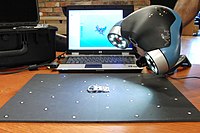
Photo from wikipedia
Artificial intelligence (AI) has emerged as a promising approach for automatic contouring in radiation therapy, compared to previous attempts, that is, image value thresholding, Atlas-based, and so forth. Results from… Click to show full abstract
Artificial intelligence (AI) has emerged as a promising approach for automatic contouring in radiation therapy, compared to previous attempts, that is, image value thresholding, Atlas-based, and so forth. Results from a 2017 AAPM Grand Challenge show that AI, specifically deep learning (DL),outperformed the previous gold standard model-based methods for contouring thoracic anatomy on CT images.1 In recent years, many clinics have started to adopt in-house or commercial AI-based autosegmentation tools in the clinic for various disease sites, as an attempt to save manual contouring time and speed up clinical workflow,as well as increasing contour quality consistency.Notice that for the majority of clinics, the group who develops or implements this tool (physicists) is often not the same group who routinely uses it (dosimetrists and physicians). Initial user feedback and satisfaction of these AI auto-segmentation tools are highly heterogenous and inconsistent with the reported advantages and benefits in numerous publications. The dissatisfaction is mainly two folds: (1) the time saving on creating contours is diminished after having to manually correct for each contour,(2) the performance of the autosegmented contours varies greatly and sometimes can
Journal Title: Journal of Applied Clinical Medical Physics
Year Published: 2022
Link to full text (if available)
Share on Social Media: Sign Up to like & get
recommendations!